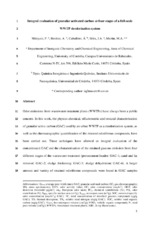Integral evaluation of granular activated carbon at four stages of a full-scale WWTP deodorization system
Autor
Márquez, P.
Benítez de la Torre, A.
Caballero, Álvaro
Siles, J.A.
Martín, M.A.
Editor
ElsevierFecha
2021Materia
Emitted gaseous compoundsGranular activated carbon
Multi-technical analysis
Odor contribution
WWTP
METS:
Mostrar el registro METSPREMIS:
Mostrar el registro PREMISMetadatos
Mostrar el registro completo del ítemResumen
Odor emissions from wastewater treatment plants (WWTPs) have always been a public concern. In this work, the physico-chemical, olfactometric and textural characterization of granular active carbon (GAC) used by an urban WWTP as a deodorization system, as well as the chromatographic quantification of the retained odoriferous compounds, have been carried out. These techniques have allowed an integral evaluation of the contaminated GAC and the characterization of the retained gaseous emission from four different stages of the wastewater treatment (pretreatment header: GAC-1; sand and fat removal: GAC-2; sludge thickening: GAC-3; sludge dehydration: GAC-4). A larger amount and variety of retained odoriferous compounds were found in GAC samples from the wastewater line deodorization (GAC-1 and GAC-2) after the same operation time (one year), GAC-1 being the adsorbent bed that retained the highest mass of volatile compounds (approximately 150 μg/g GAC). Furthermore, some variables such as the removed specific odor concentration and free micropore volume were inversely correlated (R2 = 0.9945). The analysis of odor contribution showed that sulfur-containing compounds were the major odor contributors (61–97%). However, hydrogen sulfide cannot be considered a key odorant in this particular WWTP, since the elimination of this compound does not reduce the significant contribution of other (organic) sulfur compounds to the global odor (especially dimethyl disulfide). Consequently, multi-technical analysis might be a suitable alternative to better understand odor removal by GAC adsorption.

